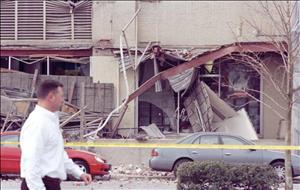At 10:54 a.m. on February 28, 2001, a deep earthquake centered near the Nisqually Delta northwest of Olympia startles the entire Puget Sound region and causes more than $1 billion in damage to area buildings and roads. The 40-second quake, calibrated at a magnitude of 6.8 on the revised Richter Scale, injures an estimated 200 persons in the region, and is cited as the cause of a fatal heart attack in Burien. Hardest hit structures are located in Olympia, including the State Capitol, and in Seattle's historic Pioneer Square. The quake is the strongest since 1949, although a "weaker" 1965 temblor caused more damage and was blamed for seven deaths.
Shaken, Not Stirred
Scientists quickly placed the epicenter of the earthquake at approximately 30 miles below the Nisqually River delta, a point 11 miles north of Olympia, along a subduction zone in which the Juan de Fuca tectonic plate is sliding beneath the North American plate. A 7.1 magnitude earthquake originated in this same area on April 13, 1949, killing eight and causing substantial property damage.
The depth of the most recent quake helped to blunt its impact on the surface, although it was felt as far away as Vancouver, B.C., and Salt Lake City. Deep "subduction" quakes generally do not produce aftershocks, but two minor jolts were recorded during the night, and the danger remains for residual landslides of loosened soils.
Crash Wednesday?
Day-after reports listed more than 200 injuries across the region. A woman in Burien suffered a heart attack during the quake, and her husband could not contact emergency services in time to save her due to jammed phone lines. Six persons remained in treatment for earthquake-related injuries at King County's Harborview Hospital one day after the event.
Initial damage estimates ranged from a low of $1 billion to as much as $3 billion. Older private and government buildings, including the State Capitol in Olympia, sustained serious damage, as did several buildings in Seattle's historic Pioneer Square district, where brick fascia and cornices toppled from several buildings, crushing parked automobiles but, miraculously, missing pedestrians. Following on the previous day's "Fat Tuesday" riots, some dubbed the latest disturbance in Pioneer Square "Crash Wednesday."
Boeing Field and other facilities in Seattle's industrial area also suffered, in part because they stand on former Duwamish River mudflats drained and filled early in the twentieth century. The headquarters of Starbucks Coffee, which occupies the original 1913 Sears & Roebuck center (once the world's largest building by volume), sustained serious damage to its fascia and internal systems.
Radar vs. Sonar
Windows in the control tower at Seattle-Tacoma International Airport shattered and air traffic management was shifted to a temporary center. One of the airport's two runways cracked, and flight operations were cut in half.
In Seattle, Microsoft co-founder Bill Gates was interrupted while demonstrating the new Windows XP program at the Westin Hotel. Meanwhile, animals at the Woodland Park Zoo sensed what the best human instruments could not detect. Seconds before the quake struck, keepers reported that the orangutans began to bellow and the elephants (attuned to sounds far below the threshold of human hearing) became agitated. Pets all over the area disappeared for hours into secret hidey-holes.
Not The Big One... Yet
The Alaskan Way Viaduct, which engineers had previously identified as seismically vulnerable, remained open to traffic for several hours before being closed for inspection. The elevated, double-decked roadway closely resembles the Oakland viaduct which collapsed during the 1989 Bay Area quake. Engineers credited stricter seismic codes and aggressive reinforcement of older structures during the 1990s for preventing much more serious property damage.
Seismologists and disaster planners emphasized that this was not "the big one" many fear will inevitably strike the area. Their worst scenario is a strong, shallow shift along the "Seattle Fault" which runs directly beneath the city core. This fault was identified in the 1990s and is believed to have caused a devastating quake in A.D. 900.

